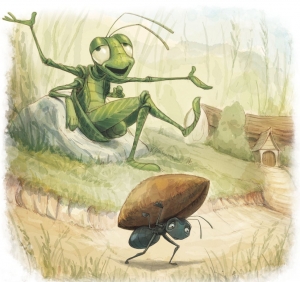The Advice Circle
This activity, apart from being a lot of fun, helps the children develop a metacognitive (self-monitoring) attitude towards (moral) decision-making. For instance, if you are discussing a child’s own behavior with them, you could say, ‘What would you advise yourself to do in situation X? You know, like you advised the ant in last week’s philosophy session.’ Begin by reading or telling the story or scenario to the class. Stop the story at whichever point is appropriate; it may be just before the characters do something in particular (to advise), or it could be just after (to evaluate), or both (to advise and then to evaluate). Another way to vary this is to have class members take on the role of the character in order to have the class advise/evaluate a ‘real person’ and to have some kind of interaction between the class and the character. Some children will really enter into the role-play aspect of this activity, representing views they don't necessarily hold but that are consistent with the character from the story. This offers a further position of remove for the children to inhabit, away from ‘themselves’ and towards an ‘other’. Here’s the procedure with the story of The Ant and The Grasshopper. (It would work well with dialogues too. See https://www.philosophy-foundation.org/blog/dialogues-in-philosophy-with-children )

- First of all, read or tell the story. (To use 'The Ant and the Grasshopper', head over to the Enquiries section of our website by clicking the link here. You will need to be a member to see this page, but joining is free.)
- Stop at the designated point, in this case, when the Grasshopper knocks on the ant’s door to ask for shelter from the harsh winter.
- Say: Usually, when we hear a story, we find out what happens in the story, whether we agree with what the characters did or not. You don’t usually get to tell the characters what you think; you don’t usually get to offer them any advice so that they can do what you think is the right thing. Today, you will!
- Place the two chairs in the talk circle, in this case, one for the Grasshopper and one for the Ant (you may want to label them for clarity)
- Ask for two volunteers: one to play the Grasshopper and one the Ant.
- Explain that the volunteers role-play, that is, they will speak to each other as if they are the Ant and the Grasshopper.
- Allow short exchanges between the two characters. Stop them when there is something to discuss (e.g. Ant: ‘You should have listened. You’re not getting anything from me. Maybe now you’ll learn your lesson.’)
- Now turn to the rest of the class and ask them: ‘Is there anyone who would like to say something to the Ant or the Grasshopper?’ If necessary, add: ‘Do you agree with what they have said?’ This might help to engage them critically. If children refer to the children playing the characters (‘I think Thomas was mean!’) then correct them (‘You think the Ant was mean!’) so that the actors don’t take it personally.
- After each short exchange have different children come up to play the characters. Encourage them to say something different to what has been said already (e.g. Grasshopper: ‘Please help! I’ll never do it again. I should have worked in the summer!’)
To facilitate you may need to offer some options to help open the issues up, such as asking for the group to consider unexplored lines of enquiry, ‘Are there any reasons why the Ant should say ‘Yes, I will help you’?’ especially if the children are saying similar things. Unanimity can sometimes happen because the narrative urges them to a particular view.
Though I’ve illustrated the procedure through the example of the story of The Ant and The Grasshopper, it can be used in many narrative situations where you want to activate the moral agency of the class/audience. Try it with The If Odyssey, stories from Once Upon an If (particularly ‘The Sindbad Stories’) and The If Machine such as ‘Billy Bash’, ‘The Lie’, with any ‘dilemma’ picture/story books such as The Tunnel by Anthony Browne, or dialogues (see link). You will often find little ‘dilemma’ moments (that one could almost overlook!) in books where you can invite the children to engage, such as in Jon Klassen’s lovely book This Is Not My Hat in which the little fish has asked a lobster not to tell the big fish where he has gone, the big fish then arrives at where the lobster is. Before turning the page to reveal what they lobster does, invite someone up to be ‘the lobster’ and someone else up to be the ‘big fish’, then turn to the audience and ask them. Also, make use of my ‘is-ing and oughting’ (see the lesson plan for The Ant and The Grasshopper for more on is-ing and oughting) strategy here and break up the questions you ask into conceptually distinct parts:
- What do you think X will do? (‘would’ indicates an ‘is’ situation)
- What do you think X should do? (‘should’ indicates an ‘ought’ situation)
- What would/should you do if you were X?
- What would/should you do if you were you in that position?
Posted by on 13th March 2017 at 12:00am
Category: Philosophy, P4C, Education




